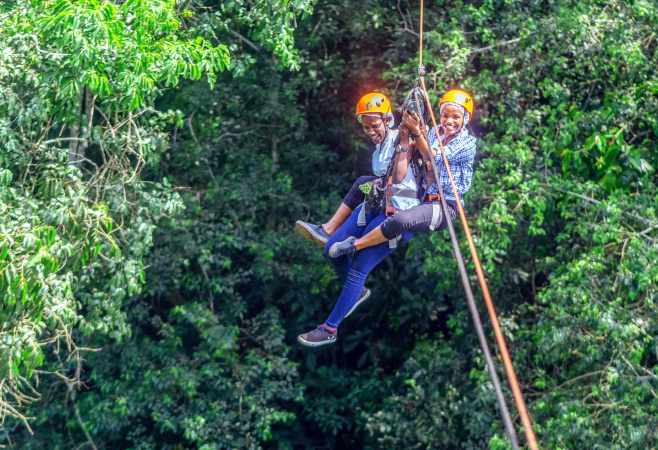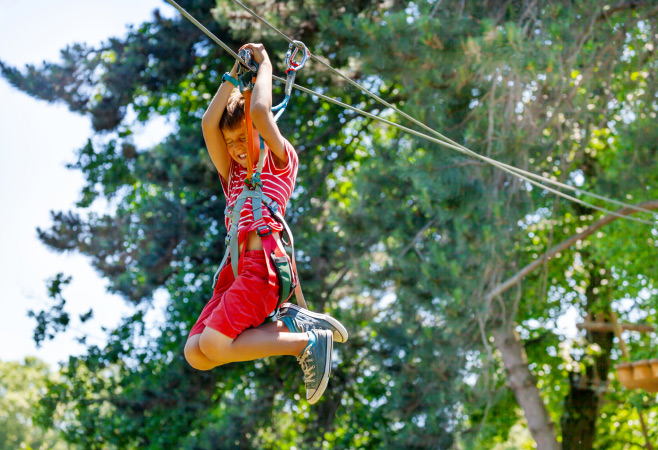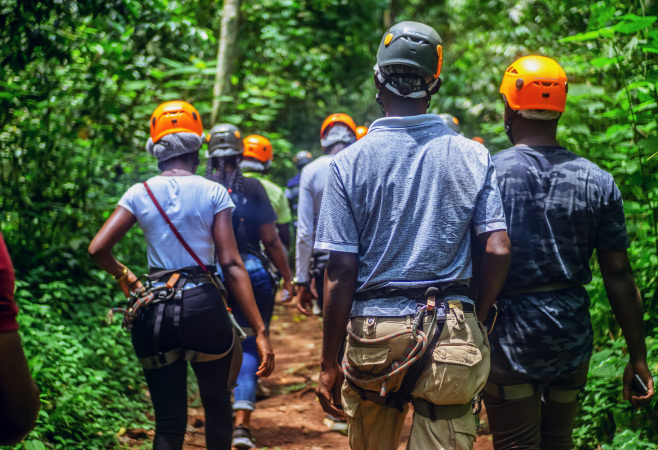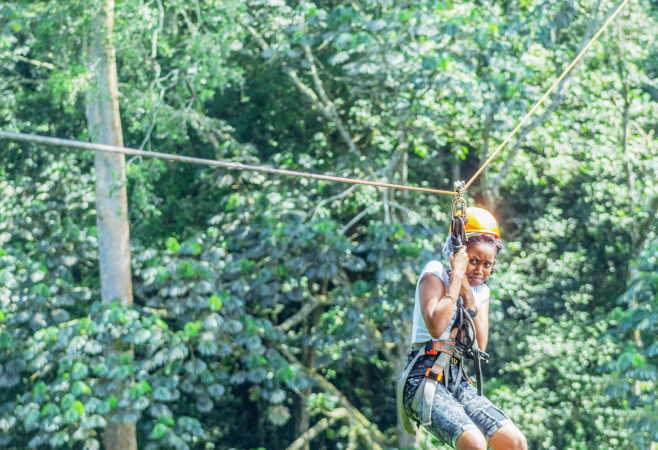Ziplining in Uganda: Discover the most scenic and exciting spots
Ziplining in Uganda has become a recent and exciting controlled eco-tourism activity. Having forest reserves, lakeside cliffs and mountainous topography, Uganda has now a number of zipline hubs that are visited by both domestic and international adventurers. This article explores the legal environment, operational regulations and top ziplining locations across Uganda.
- Legal and regulatory framework
- Popular ziplining locations in Uganda
- Pricing and average costs for ziplining in Uganda
- Best time to experience ziplining in Uganda
- Booking guidelines and cancellation policies
- Operational requirements
- Tourist experience and rights
- Benefits of ziplining in Uganda
- Challenges facing ziplining operators
- FAQs
- Conclusion

Ziplining in Mabira Forest
Legal and regulatory framework
Uganda's Ministry of Tourism, Wildlife and Antiquities, in collaboration with the Uganda Tourism Board (UTB), oversees the licensing and regulation of adventure tourism activities, including ziplining.
Licensing and permits for operators
Operators are required to obtain business registration, tourism activity permits and environmental permits. The Uganda Investment Authority (UIA) and National Environmental Management Authority (NEMA) usually work together to achieve safety and sustainability.
Safety regulations and liability issues
The operators must legally keep certified safety equipment, perform regular checks and employ trained instructors. Furthermore, liability waivers should be signed by all clients and they should be instructed about safety measures. The harm that may be caused by the operator through negligence can result in civil claims or criminal cases.
Popular ziplining locations in Uganda
Uganda offers diverse landscapes ideal for ziplining, from thick tropical forests to lakeside hills and urban fringes.
Buloba forest park ziplining
Located west of Kampala, Buloba Forest Park is a leading ziplining destination for locals.
Facilities and safety standards
With a dedicated adventure course, Buloba Forest Park ziplining complies with national safety laws, offering helmets, harnesses and guided rides. Staff undergo routine safety drills and the course is annually inspected for compliance.
Ziplining at Lake Bunyonyi
Situated in southwestern Uganda, Lake Bunyonyi is famed for its serene beauty and unique topography.
Scenic beauty and legal considerations
Ziplining at Lake Bunyonyi not only offers adrenaline-packed views of the lake’s 29 islands but also falls under local council oversight. Operators must obtain permits from Kabale District authorities and EIAs are mandatory due to the sensitive ecosystem.

Ziplining at Lake Bunyonyi, Uganda
Ziplining in Jinja
Jinja, known for the Source of the Nile, is a hotspot for adrenaline sports, including ziplining.
Nile high bungee vs ziplining
While bungee jumping dominates headlines, ziplining in Jinja offers a scenic alternative over treetops and valleys. Operators must liaise with Jinja City Council and UTB for compliance.
Ziplining in Entebbe
Entebbe’s forest canopy provides a suitable ziplining terrain within proximity to Kampala.
Forest canopy access and guidelines
Ziplining in Entebbe often operates near the Botanical Gardens. Legal restrictions demand minimal tree interference, with platforms built around - not through - trees. Conservation licensing is mandatory.
Ziplining in Kampala
Urban ziplining in Kampala is a novelty, mostly offered at private eco-resorts and amusement parks. Zoning laws require prior municipal authorization and facilities must conform to Uganda National Bureau of Standards (UNBS) safety certifications.
Ziplining in Mukono
Mukono is a green hilly area that has a number of upcoming zipline tracks. Licensing is still decentralized and is done by the district under NEMA direction.
Pricing and average costs for ziplining in Uganda
Ziplining in Uganda is also not too expensive when compared to other foreign adventure tourism destinations. The charges vary depending on the place, the challenge, the time and the availability of some additional services in the package such as guided nature walks or transport.
The lowest tariff of a normal zipline at the tourist attraction sites such as Buloba Forest Park and Jinja is about UGX 40,000 to UGX 100,000 (approximately USD 10 to USD 25). High-end activities such as multi-platform courses or ziplining over lakes such as Lake Bunyonyi may cost as much as UGX 150,000 (approx. USD 40). Discounts are usually offered in groups, particularly school trips, corporate team building or tour groups.
It is worth mentioning that foreign visitors might be charged a little higher than the Ugandan national but this is a pricing model that is permitted under the tourism-tier pricing policies as long as it is openly disclosed in advance. According to the standards set by the Uganda Tourism Board (UTB), all prices should cover the safety gear rental, basic insurance, and a certified guide.

Boy scream and fast slide zip line with trolley
Best time to experience ziplining in Uganda
Tropical climate in Uganda is characterized by wet and dry seasons and the same weather conditions directly regulate the safety and enjoyment of ziplining activities. The best time to engage in ziplining in Uganda is during the dry seasons, which are normally between December and February and June and August. The trails are more stable during these periods, visibility is good and the wind conditions are favorable to aerial activities.
On the other hand, in the rainy seasons - particularly between March and May, and September and November, most zipline operators cut down on the number of hours of operation or completely shut down services to avoid the danger of slippery platforms and decreased braking effectiveness. During these months, tourists are encouraged to make an advanced check on operating hours and not to make last minute reservations.
Risk mitigation protocols obligate operators to place weather-related suspensions 24 hours in advance and inform customers of bookings that are subject to weather conditions through email or phone.
Booking guidelines and cancellation policies
Most ziplining companies in Uganda now accept online bookings or WhatsApp bookings, particularly in tourist-concentrated areas like Jinja, Kampala and Lake Bunyonyi. Whereas walk-in participation is welcome in some areas, it is extremely recommended to make reservations during the weekends, holidays or school holidays where the attendance of the participants surges to unprecedented levels.
According to the norms of tourism in Uganda, the zipline operators have to have a well spelt out policy of cancellation and refund. Generally, the following rules are used:
- Full refund if cancellation is made 48 hours or more before the scheduled activity.
- Partial refund (50%) if cancellation is made within 24–48 hours.
- No refund for cancellations made less than 24 hours in advance or for no-shows.
There are operators that can provide vouchers based on rebooking in the event of an illness or weather. It is recommended that clients read the cancellation policy when booking and seek a written confirmation of any refund arrangement, particularly where payment is made in advance by bank transfer or mobile money.

First-time zipliner celebrates the descent in Mukono
Operational requirements
Operators must navigate complex regulatory environments, ensuring compliance at every level.
Environmental impact assessments (EIA)
For ziplining projects in ecologically sensitive areas, an Environmental Impact Assessment (EIA) is often required to ensure minimal disruption to nature. These evaluations ensure that the activity doesn't disrupt wildlife, deforestation boundaries or indigenous plant species.
Insurance and risk management
Operators are legally bound to carry liability insurance. Tourists, too, are encouraged to have personal travel and accident insurance before participating in ziplining adventures.
Tourist experience and rights
Tourist responsibilities
While operators must ensure safety, tourists have a duty to follow instructions, wear protective gear and disclose any medical conditions that could interfere with the activity.
Refunds, waivers and consent forms
Every zipline operator must provide waiver forms explaining risks. These are legal documents that absolve the operator from some - but not all - liabilities. Refund policies must be transparent and pre-communicated.
Benefits of ziplining in Uganda
Ziplining extends beyond recreation; it serves legal, economic and environmental purposes.
Tourism revenue and economic growth
Adventure tourism, including ziplining, has increased Uganda’s tourism receipts by fostering local employment and increasing regional visibility.
Environmental awareness and conservation
Many operators integrate conservation education into ziplining experiences, promoting forest protection and reforestation awareness among tourists.
Challenges facing ziplining operators
Despite its growth, the zipline industry in Uganda faces significant hurdles.
Regulatory compliance
Frequent law changes and bureaucratic delays in licensing discourage some potential investors. There’s a push for the Uganda Tourism Act to be updated to better accommodate adventure tourism.
Infrastructure development
Poor road access to remote zipline areas, power outages and insufficient emergency response systems challenge consistent service delivery and raise safety concerns.

Ziplining in Kampala brings the wild to the city
FAQs
- Is ziplining in Uganda safe for tourists?
Yes. Operators are required by law to adhere to safety regulations including certified equipment, trained staff and emergency procedures.
- Do I need insurance to go ziplining in Uganda?
While not legally required for tourists, it is highly recommended to carry travel or accident insurance when participating in adventure sports.
- What is the legal age to participate in ziplining activities in Uganda?
Most operators require participants to be at least 12 years old. Parental consent is mandatory for minors.
- Can I zipline in Kampala city itself?
Yes, there are a few eco-resorts and parks in Kampala that offer regulated ziplining experiences.
- Are there any legal restrictions for foreigners operating ziplining businesses in Uganda?
Yes. Foreign investors must comply with UIA regulations, acquire tourism business permits, environmental clearances and adhere to foreign investment laws.
Conclusion
Ziplining in Uganda is not merely a recreational thrill but a controlled and expanding sub-sector in the adventure tourism sector. Environmental sustainability and safety requirements are most important along with legal compliance. Uganda is already on the path to becoming the best ziplining destination in East Africa with its beautiful landscape and the rising number of tourists visiting the country - as long as the ziplining operators and regulators continue working together.
Related Articles
- Entebbe Botanical Gardens Entrance Fee to Uganda’s Green Paradise
- Uganda Reptile Village: Where the Wild Side of Nature Gets Scaly
- Ngamba Island Chimpanzee Sanctuary: Uganda’s Primate Paradise
- Uganda Wildlife Conservation Education Centre: Where Learning Meets Adventure
- Pearl Crafts Village Uganda: A Colorful Stop You Shouldn’t Miss
- Mabamba Swamp Bird Watching: A Wild Adventure You’ll Never Forget
- Hot Air Balloon in Uganda: Best safari locations & tips for tourists
- Budongo Forest in Uganda: Chimpanzee trekking guide
- Ngamba Island Chimpanzee Sanctuary: Top wildlife experience
- Accommodation in Uganda: Best hotels, lodges, campsites











